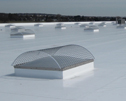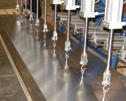It is difficult to imagine a construction work site—especially one involving roof system removal and/or installation—without a fair amount of visible dust. Environmental, health and safety professionals rightly focus on hazards related to dust generated from cutting products containing sand; asbestos fibers in dust created during demolition or installation operations; and a variety of other dusts that pose risks to workers.
However, some recent manufacturing-related incidents have drawn attention to the risks associated with another type of dust that—though rare at construction work sites—can have catastrophic effects: combustible dust.
Different from other dust types, combustible dust's significant hazard is not related to worker inhalation, absorption or ingestion of dust but fire and explosion hazards associated with dust.
Effects and risks
According to the Occupational Safety and Health Administration (OSHA), combustible dusts are solids ground into fine particles, fibers, chips, chunks or flakes that pose a fire or explosion hazard when suspended in air under certain conditions. OSHA recently published OSHA 3371-08 2009, "Hazard Communication Guidance for Combustible Dusts" to assist manufacturers and importers of materials likely to produce combustible dust by identifying protective measures and providing pertinent information on material safety data sheets.
In the guidance document, OSHA cites five elements necessary for a combustible dust explosion: combustible dust, an ignition source, oxygen, dust dispersion in sufficient quantity and concentration, and the dust cloud's confinement.
Combustible dust's most serious effects can be devastating as the following cases have demonstrated:
- In 2008, a sugar dust explosion and fire at a sugar refinery killed 14 workers and left many others seriously burned.
- In 2002, five workers died in an explosion at a rubber fabricating plant when accumulated rubber dust ignited.
- One worker was killed in a series of explosions at an automotive wheel manufacturing plant when aluminum dust ignited.
- Six workers died at an electric power generating plant when coal dust in the facility ignited and exploded. Fourteen other workers were seriously injured.
Combustible dust hazards typically must be addressed by the operator of a facility in which material that may produce combustible dust is manufactured, processed, ground or otherwise handled.
Roofing-related concerns
For roofing contractors, it can be difficult to fully understand the processes undertaken in facilities where roofing work is being performed. Such limited awareness is potentially dangerous when roofing workers are exposed to dust, fumes and vapors vented from interior operations through roof exhaust vents.
However, when OSHA first instituted a National Emphasis Program on combustible dust in 2008, it provided a list of industries with more frequent or high-consequence combustible dust explosions and fires. Such industries include wet corn milling; electric energy transmission or distribution; flour or grain milling; chemicals and chemical preparation; electroplating; smelting and refining nonferrous metals; pharmaceutical preparation; sawmilling; sugar refining; and aluminum foundries.
Be aware
Although a combustible dust hazard is unlikely during roofing operations, you should be aware of exhaust systems, dust collection systems and explosion prevention systems employed at facilities and located near rooftop operations. Efforts then can be made to avoid compromising those systems' functions, thereby reducing the chance of combustible dust fires or explosions.
Harry Dietz is NRCA's director of risk management.



